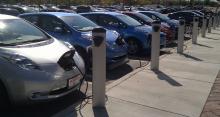
The MSRC provided funding to the UCLA Luskin Center for Innovation to identify certain locations in the South Coast Air Quality Management District with likely high demand for electric vehicle charging. Now, this important data has been added to the Southern California Plug-in Electric Vehicle Atlas. This interactive mapping tool is hosted by the Southern California Association of Governments and allows users to explore data, such as current charging stations, electric vehicle (EV) registrations and destinations, and commercial destinations, to best inform where new charging stations should be located.
The update to the Atlas allows users to add data layers that show where unmet demand is for workplaces and for multi-unit dwellings (MUD), such as apartments and condominiums. This is important because these locations often have challenges in attracting EV installations. Creating sufficient EV charging will be critical to meeting the Governor’s Executive Order to achieve 100% new zero emission vehicle sales by 2035.
In the South Coast region, there are more than 2.3 million MUD housing units, which makes up 44 percent of the total housing stock in the region. Property owners often don’t see the benefit of investing in EV infrastructure if they don’t view it as an amenity that tenants want or that can justify higher rents. Tenants often don’t want to spend their own money to improve a property that they do not own. This is why the new data in the Atlas is so valuable – it allows users to find which properties have residents with a higher likelihood of purchasing an EV, which would make them more likely to invest in EV infrastructure or motivate their landlord to invest.

The Atlas also can help users strategically target workplaces that may be more amenable to installing EV chargers for employees. Since many employees spend the majority of the day at the office, not having a place to charge at work can often be another barrier to EV purchases. The Atlas enables users to see which workplaces have a higher potential to benefit from EV charging by displaying locations where EV charging is being underutilized. Users can then overlap this information with the location of larger employers, which would have the highest concentration of drivers, to enhance the likelihood that chargers would be used on a regular basis.
The hope is that local and regional planners who are working to deploy EV charging in Southern California will use this new data to expand their targeted locations to multi-unit dwellings and workplaces. They can use this data to reach out to property owners and employers where there is a greater likelihood for EV charging demand to encourage the installation of charging infrastructure, which will help grow the number of EVs on the road and reduce local air pollution.
